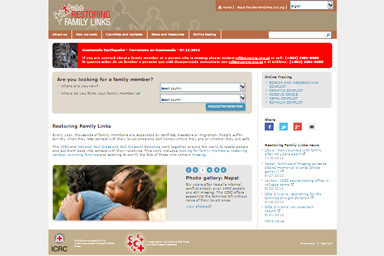New family links website: Restoring contact in a crisis
13-11-2012 Interview
New ICRC website familylinks.icrc.org will enable people separated by conflict or disaster to get back in touch. Olivier Dubois, deputy head of the Central Tracing Agency and Protection Division of the ICRC, explains why the ICRC created the site and how it will improve people’s chances of finding those they are looking for.
Why did the ICRC set up familylinks.icrc.org?
We created the site to address a fundamental need of the millions dispersed by war, disaster, migration and other emergencies: the need to get back in touch with a loved one, whether by simply exchanging a few reassuring words or by being reunited with them.
We developed this simple, user-friendly website together with Red Cross and Red Crescent Societies for people who want to restore contact with relatives during or after a crisis. Wherever they may be, people looking for a family member can now access a full range of personalized services with just a few clicks.
We believe that through this site, many more people will learn about the tracing services of the International Red Cross and Red Crescent Movement, and how to use them. We may well see an increase in requests to the National Societies and the ICRC, and we hope to improve public awareness of the service and support for it.
How widespread is the problem of separation? How many people does it affect?
Separation is a problem wherever there is war or disaster. It tears the lives of families apart, and its consequences are often felt for decades. It affects people of all ages, in many different circumstances. For some of them, separation will mean death.
In Uganda, children who fled the fighting in the Democratic Republic of the Congo last year are still hoping to be reunited with their families and communities back home. In Jordan, Syrian refugees are eager to get back in touch with the relatives they left behind. Each situation is different and has its own challenges, but the fact remains that people are stronger if they can hold together during hard times, and every possible effort must be made to help them keep in touch.
In 2011, for example, the ICRC received more than 12,700 new tracing requests from people looking for their relatives. That same year, with the help of the National Societies, we facilitated almost 220,000 phone calls between family members worldwide. We also helped reunite about 1,500 children with their families.
How does the website work?First off, it provides information on the services available all over the world, and explains how to contact National Societies and ICRC offices.
In certain cases, users can make enquiries online via the website and launch a tracing request in real time. For the first time, we are clearly explaining the “acceptance criteria” to the public. These won’t be the same everywhere; every situation is different, the organizations that make up the Red Cross and Red Crescent network have varying capabilities, the logistics involved vary and so does the security situation. At the same time, the tracing services of the International Red Cross and Red Crescent Movement adhere to certain principles that are the same all over the world.
Before this site was created, websites were launched whenever a crisis occurred. What’s really different about familylinks.icrc.org?
What makes the familylinks.icrc.org website unique, and superior to other web-based services, is that it allows for interaction with people who are trying to restore contact with their relatives. ICRC and National Society staff around the world follow up on requests personally. No other organization in the world can do this.
We designed the new familylinks.icrc.org site on the basis of experience gained with other websites over the years. Previously, we used to set up a new special website every time disaster struck or conflict broke out. People could leave "safe and well" messages, consult names of missing persons and ask for news of people they were looking for. In 2009 alone, people published 83,000 names on such sites. This is what we did for the Balkans conflict in the nineties, the earthquakes in Haiti and Japan, and the conflicts in Iraq, Nepal and Somalia. We closed some of these websites once the crisis was over, whereas the new website will stay up permanently and will cover every part of the world.
What about the protection of personal data?
Protecting enquirers, protecting those they are seeking and protecting their personal data is of major concern to us. Only authorized Red Cross and Red Crescent personnel will be able to modify data on the site. This is a major difference by comparison with other websites, where data is often visible to everyone, and anyone can modify it.
What about languages other than English?
Our goal is to make familylinks.icrc.org a truly multilingual site, to match the changing environment in which we provide our services. Initially, the site will just be in English, but with lists of missing persons in local languages. We’re working on French and Spanish versions, and they’ll be followed by Arabic. And we will make selected elements and pages available in a number of other languages, such as Chinese, Farsi, Portuguese, Russian, Swahili, Tamil and Urdu.

